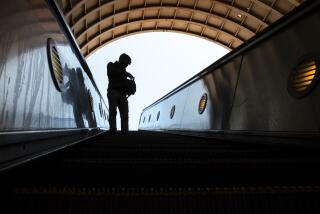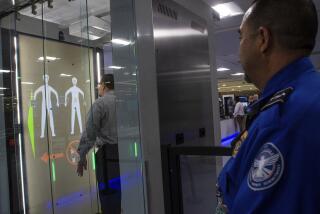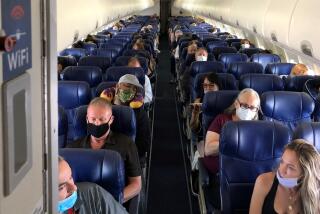Technology Alone Cannot Guarantee Safe Skies : Security: A government report says humans remain the key link in sophisticated anti-terrorist systems.
While progress has been made in upgrading airline and airport security, there still isn’t a foolproof system or device on the horizon that will insure total safety for air passengers.
That was among the findings in a 142-page report, “Technology Against Terrorism: Structuring Security,” prepared by the Congressional Office of Technology Assessment and released earlier this year.
Several chapters of the report are devoted to aviation security. Among other findings:
* The most effective security approach is one that integrates several methods of detecting explosives, instead of relying on just one.
* Various enforcement agencies are doing a better job at working together, but more research and coordination needs to be done.
* Airports and airlines need to keep sharp by anticipating changes in terrorist tactics.
* Technology cannot replace people, who are still the key to analyzing information.
“There doesn’t appear to be any panacea coming that shows promise of producing total airline/airport security in the next three to five years, so we have to improve and enhance what we have to make the best use of existing technologies and methods,” said Bill Jackman, a spokesman for the Air Transport Assn.
The Federal Aviation Administration is currently sponsoring a major study of security provided at the Baltimore/Washington International Airport in an attempt to find the right balance among various security methods. According to FAA spokesman Paul Steucke, the study, expected to be completed by December and evaluated by next May, includes the redesign of passenger screening areas and possible changes in the placement of detection equipment.
Another finding from the OTA report indicates that more widespread use of effective passenger profiles is essential to airline security. Such profiles are expected to reduce the burden on bomb-detection technology. The FAA now requires certain information relating to passenger travel plans and preparations to be considered by airport security personnel in judging whether a particular passenger should receive a higher level of scrutiny.
Additionally, the report says, airlines should conduct random baggage inspections on a small percentage of those passengers who are not selected for closer scrutiny by any profiling. However, these requirements apply only to international flights by U.S. airlines, not domestic flights or flights by foreign airlines.
Some U.S. airlines, under the guidance of the FAA, have been experimenting with a semi-automated profiling system called the Comprehensive Passenger Screening Profile (CPSP). Under this system, the security person keys “yes” or “no” answers by passengers to a set of seven questions into a portable computer terminal. The mathematically weighted answers are then compared against a database to produce a risk assessment. Based on the results, the security agent then makes a judgment on whether or not to subject the passenger to more scrutiny.
The FAA is now considering making the CPSP mandatory for all U.S. airlines, on both international and domestic flights. U.S. carriers have been using the CPSP at a few airports internationally, but none domestically, Steucke said.
The two basic approaches used in the profiling procedure are: 1) comparing passenger demographic and other background data, such as nationality and travel itinerary, against the intelligence database, and 2) utilizing the security agent’s personal assessment of the passenger in terms of nervousness, hostility or other characteristics.
The report notes that more detailed profiling of passengers might be considered a violation of civil liberties, depending on which characteristics are used to determine who gets more scrutiny. Among the issues of both legal and ethical concern to be sorted out are the weight given to the demographic characteristics of passengers, and the percentage of passengers flagged by demographic criteria.
The report dealt specifically with the potential terrorist threat of bio-weapons--i.e., biological agents that include living organisms (bacteria, viruses, fungi), as well as toxins and chemicals that impact biological functions. Such agents could conceivably be introduced into aircraft equipment or used to contaminate food or water. Though such tactics have not yet been used by terrorists, the report points out that the confined space and recirculated air flow within jets could increase the effectiveness of chemical and biological agents, and that few options exist for dealing with this problem. Rapid “early warning” multi-agent detectors are now being developed.
Another new security device being developed for use at airports is an X-ray machine that uses “extremely small” doses of radiation to determine whether passengers are concealing weapons or explosives under their clothes. A suggestion that passengers be routinely X-rayed before boarding a plane would almost certainly cause a public outcry and heated debate, the report notes, and, at the very least, raises issues of privacy and safety.
“The key here is the public perception of being subjected to X-rays,” said Paul Gray, the FAA’s federal security manager at LAX. “Even though the dosage would be insignificant, this procedure will be a difficult hurdle to adopt. It would probably take an educational program to overcome the perception.”
Use of computers in conjunction with a high-resolution X-ray system to detect certain electronic components, as well as guns, knives and hand grenades, is also under development, according to the report. One of the goals of enhancing the ability of X-ray systems to locate so-called threat items is to overcome the human fatigue problem that stems from a repetitive procedure such as X-ray image inspection.
The report also calls for passenger/baggage matching to be improved for domestic travel, especially for flights that feed into international flights. Passengers can now check their baggage straight through at various hub cities on domestic flights connecting to international flights. Use of X-ray equipment at the first check-in point was not rated as a very good detection method for explosives.
As a possible remedy, the study suggested it should be possible to give priority to inter-line baggage, and use profiling information to select some passengers and their bags for closer scrutiny.
Moreover, the report indicates that the technological elements of an effective automated or semi-automated baggage-matching system are already available. For example, bar code technology is already used by some carriers to both route and track baggage from the check-in counter to the plane. Bar codes, which are read by special bar-code reading equipment, are used on baggage tags as well as on the passengers’ tickets to identify luggage.
The ability to match baggage brought aboard from another airline with the proper passenger is considered vital. The bomb that destroyed Pan Am Flight 103 over Lockerbie, Scotland, in December, 1988, is believed to have been put aboard the doomed jet as inter-line baggage in Frankfurt.
Another possible opening for terrorists being targeted by the FAA for closure, according to the report, involves aircraft and cargo containers. Security officials hope to harden the containers to help minimize bomb damage. The objective is to force terrorists to use a greater amount of explosives to destroy a plane, which in turn would make it easier to detect the explosives. Adding liners to the baggage department to try to absorb or slow shrapnel is another security option under consideration.
A drawback to these ideas is the greater weight of the plane, which would make it more expensive to fly. Passengers, thus, would likely face higher fares.
More to Read
Inside the business of entertainment
The Wide Shot brings you news, analysis and insights on everything from streaming wars to production — and what it all means for the future.
You may occasionally receive promotional content from the Los Angeles Times.










